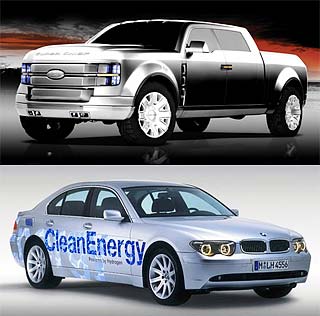H2ICE Cars
Some people think that hydrogen cars are synonymous with hydrogen fuel cell vehicles, but this is not necessarily so. Another class of hydrogen car is called H2ICE or H2 (hydrogen) burned inside an internal combustion engine (ICE).
|
In fact, the early history of H2ICE vehicles dates back to 1807 when Francois Isaac de Rivaz of Switzerland built the first working model. It wasn’t until 1966, when GM put an experimental fuel cell inside its Electrovan that FCVs (fuel cell vehicles) began to catch on.
|
 |
Some of the more well known H2ICE vehicles are the BMW Hydrogen 7, the Mazda vehicles, and several Ford models. I had the pleasure of driving the BMW Hydrogen 7 a couple of times at various events in Southern California.
The BMW Hydrogen 7 is a luxury car with an internal combustion engine that can burn either gasoline or super cooled liquid hydrogen fuel. Just a press of a button seamlessly switches the car between the two fuels.
Mazda has two vehicles, the RX8 Renesis RE Hydrogen and the Premacy RE Hydrogen that both have rotary engines and run on compressed hydrogen gas. According the Mazda the rotary engine is the perfect H2ICE because of its design which prevents knocking and pinging.
The Mazda vehicles have been used in the cool regions of Norway for their Hynor hydrogen highway project. Ford has developed both fuel cell vehicles and H2ICE vehicles. The Ford Superchief F250 is actually a tri-fuel vehicle that can run on hydrogen, gasoline or E85 ethanol.
Ford has also built and rolled out around 20 E-450 and F-450 H2ICE shuttle buses combined for various projects. Only a couple are still operational in the U. S., but 10 are still operational in Canada.
The Ford Focus FCV was developed by the automaker as a hydrogen fuel cell electric vehicle. But, a couple other companies such as Quantum Technologies in the U. S. and Revolve in the UK, have taken standard Ford Focus cars and retrofitted them to be H2ICE vehicles.
So, even though hydrogen fuel cell vehicles are popular now days because they are classified as zero emissions vehicles, the H2ICE still has a couple of advantages. For instance, the H2ICE is near-zero emissions. A standard ICE can be converted to run on hydrogen including fittings and tanks for between $30,000 and $70,000, which is way below the price of a hydrogen fuel cell vehicle that costs in the $100,000’s to build.
So, don’t count the H2ICE out just yet. It’s been here for over 200 years and chances are it will be around a little while longer.
Written by Hydro Kevin Kantola